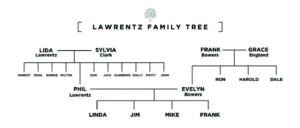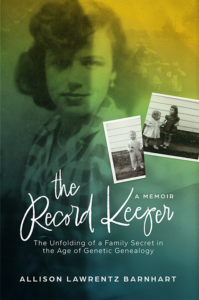CHAPTER 3
DECONSTRUCTION
Summer, 2007

Not long after my video interview with Grandma, summertime brought an opportunity to see a piece of family history up close. My sister Sam and I drove the five hours south from Ashland to Spencer, West Virginia, a small rural town that wasn’t really on the way to or from anywhere. All we knew was that a log cabin once belonging to the Lawrentz family remained on a few acres of land off of Missouri Fork Road. Our third great-grandfather Noah Lawrentz settled there along with his family after moving west from Lewis County, and prior to that, Fauquier County, Virginia.
Our parents and younger sister Elizabeth planned to join us later in the day. Once we had all arrived at the motel, we made our way out to the cabin site. Growing up, our family had spent summers visiting historic landmarks across the country during past vacations, but this trip was different. This time we had a chance to personally connect with a historic site like we never had at The Corn Palace, Four Corners, or Wall Drug. It was no doubt a less popular destination, but the thought of seeing something from our heritage was unquestionably exciting to us.
 “Of upper Spring Creek. Noah Lawrence and his wife, Elizabeth (Allman), with the first born of their several children, five sons and two daughters, came here from their former home in Lewis or Harrison County about the year 1850. They were of the third or fourth generation of the Lawrences, early settlers of the Monongahela Valley; and came here and invested inheritances and savings in a large tract of land, virgin forest, on upper Spring Creek.
“Of upper Spring Creek. Noah Lawrence and his wife, Elizabeth (Allman), with the first born of their several children, five sons and two daughters, came here from their former home in Lewis or Harrison County about the year 1850. They were of the third or fourth generation of the Lawrences, early settlers of the Monongahela Valley; and came here and invested inheritances and savings in a large tract of land, virgin forest, on upper Spring Creek.
The spelling of the name, Lawrence, appears on the county records in different letterings; the first deed of conveyance in this name is one by Alexander; to it he and his wife append their names spelled ‘Lorentz’. Noah and his family were popular people in their part of the county for some twenty-five years.” 2
Along with the cabin, I learned (with the help of some distant Lawrentz cousins) there were stories beyond my estranged grandfather Phil we could be proud of—or were at least worth learning about. French and Indian War soldiers; victims and survivors of an Indian massacre; pioneers and members of the House of Burgesses in colonial Maryland. I pored over old records, military histories, ship passenger lists, and Google Earth views. Zooming in on land my ancestors cared for and were laid to rest on captured my imagination.
The old Lawrentz homestead appeared around the bend in the road. To our surprise, it was a demolition zone.
We proceeded with caution and saw they were in the middle of tearing white aluminum siding off the home to reveal old timbers which hadn’t seen the light of day in decades. Pink and yellow bits of insulation littered the ground like clouds of cotton candy sprinkled amid the gnarled pieces of siding, splintered off pieces of wooden trim and frames, and the odd scrap of tattered and frayed carpet.
With permission from the new owners (who happened to be nearby), we were able to walk inside and look around. Dad brought the camcorder and he and I took turns taking video as well as photos with a digital camera, trying to thoroughly document this rare piece of Lawrentz history. It gave me chills to think my ancestors lived in this very place, this humble home, taking the risk to move further west in those early days—pre–Civil War and before West Virginia knew statehood. After we finished exploring the log cabin, we drove down the country road to find the old cemetery nearby on Missouri Fork and saw the first Lawrentz headstone I had ever seen in my life. Next, we attended
a genealogical event in the town of Spencer and left feeling even more connected to our roots. I bought a Roane County Genealogical Society T-shirt to commemorate our visit.
“Maybe we can find a way to pool enough money together and buy this land back someday,” said Dad proudly.
Months later, another distant Lawrentz cousin shared how the new owners of the land were very gracious to let him have the massive old beams of the log cabin for free. He meticulously numbered and kept track of each original wooden beam and would store them until he could reconstruct the home on a piece of land he owned elsewhere in West Virginia. He told me he’d let me know when it was rebuilt, and we’d plan a big family reunion.
That old cabin had been a tangible key to reimagining our heritage. We could now see what was underneath: a rich history, not a dead end. Something ugly was covering it and kept it in the dark, but getting there at just the right time allowed us to see light hit the original structure. It was a symbol of who we were and where we came from.
2 The History of Roane County, 1927 (Roane County Historical Society, 1927).
Want more? Download the full sample and find purchase links here.
